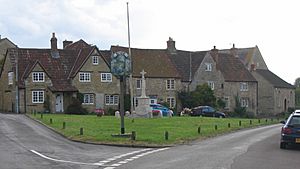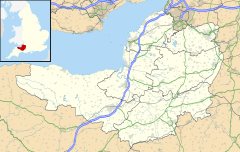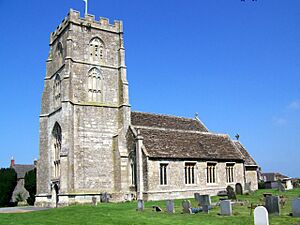Rode, Somerset facts for kids
Quick facts for kids Rode |
|
|---|---|
 Village centre |
|
| Population | 1,025 (2011) |
| OS grid reference | ST805540 |
| Unitary authority |
|
| Ceremonial county | |
| Region | |
| Country | England |
| Sovereign state | United Kingdom |
| Post town | Frome |
| Postcode district | BA11 |
| Dialling code | 01373 |
| Police | Avon and Somerset |
| Fire | Devon and Somerset |
| Ambulance | South Western |
| EU Parliament | South West England |
| UK Parliament |
|
Rode is a lovely village in Somerset, England. It's about 5 miles (8 km) north-east of Frome and 5 miles (8 km) south-west of Trowbridge.
The small area called Rode Hill is now part of the village. Rode is the most eastern village in Somerset, very close to the Wiltshire border.
Contents
History of Rode Village
How Rode Got Its Name
The village of Rode is mentioned in the old book called the Domesday Book. Back then, it was spelled "Rode." Over time, the spelling changed a lot, even becoming "Road" for a while in the 1700s.
In 1919, the local council decided to change it back to the older spelling, "Rode." The name "Rode" comes from an old Anglo-Saxon word, rod, which means a "clearing" in a forest.
Rode's Early Days
Rode started as a place where people could cross the River Frome. It grew into a big village with several important estates (called manors) and mills. By the year 1250, Rode was allowed to have a weekly market and a yearly fair. This was a big deal!
The main part of the village is near the river. There are also houses around St. Lawrence's church, which is close to Seymour's Court, where the Lord of the Manor lived.
The Wool Industry Boom
Rode was most important in the 1500s and 1600s. This was when the wool milling industry was very successful in the South West. Rode was great for wool mills because its rivers had many bends. This made it easy to build mill ponds and streams.
It was also close to Bristol, a big international port. At one point, Rode had four or five wool mills. These mills made the village very rich. This wealth helped build many large houses in Rode, like Rode Manor and Langham House.
Royal Blue Dye
In the 1700s, Rode's milling industry had a special achievement. A group of mills in Rode won a competition to make a special robe for Queen Charlotte. To win, a business in the village invented a new color dye called Royal Blue. They even got a special certificate to sell it under that name!
Changes and Modern Rode
By the late 1800s, Rode's wool mills started to struggle. This happened to many mills in the South West. The Industrial Revolution and new steam power meant that mills moved to bigger industrial cities in the north of England.
In 1937, Rode Hill became part of Somerset. Today, Rode is mostly a "dormitory village." This means many people who live there travel to work in bigger nearby cities like Bristol, Bath, Trowbridge, and Frome.
How Rode is Governed
Local Decisions
The parish council in Rode helps with local issues. They decide how much money to collect from local taxes to run the council. They also check plans for new buildings and work with the police on safety and traffic.
The council also helps keep local facilities like parks in good shape. They talk to bigger councils about roads, drainage, footpaths, and public transport. They also look after old buildings and environmental issues.
District and County Councils
Rode is part of the Mendip area. The Mendip District Council handles things like building permits, local roads, and council housing. They also manage environmental health, markets, rubbish collection, and parks.
Somerset County Council is in charge of bigger and more expensive services. These include education, social services, libraries, main roads, public transport, and fire services. They also handle waste disposal and bigger plans for the area.
Voting and Representation
The village is part of the 'Rode and Norton St Philip' electoral ward. This area stretches from Norton St Philip down through Rode to Lullington. In 2011, about 2,227 people lived in this ward.
Rode is also part of the Frome and East Somerset area for the Parliament of the United Kingdom. This area chooses one MP to represent them in the House of Commons in London.
Religious Buildings
The Church of St Lawrence was built a long time ago, in the late 1300s and early 1400s. It was repaired in 1874 and is a Grade I listed building. This means it's a very important historic building.
There is also a Baptist-Methodist chapel in Rode, built in 1809. Its gates and walls are also listed as Grade II historic buildings.
Another church, Christ Church at Rode Hill, was built in 1824. However, it was no longer used as a church after 1995. Now, it's a house and a shop that sells violins!
Village Landmarks
Rode has several interesting landmarks. You can find two old village pumps, a mounted plough, and a wellhead pump. There's also a fancy village sign, a flagpole, and a war memorial shaped like a cross. These last three are all on the village green.
A three-arch packhorse bridge crosses the River Frome. This bridge is about 48 inches (122 cm) wide and 63 feet (19 meters) long. It was used by packhorses carrying goods.
Village Amenities
Rode has many useful places for its residents. These include a village school, a pre-school, and a shop with a post office. There's also a physiotherapy and acupuncture clinic, and even a chocolate factory!
The village has a recreation ground and a cricket club, which started around 1895.
In the past, Rode had several mills. One of them has now been turned into a pub called The Mill. Other pubs in Rode are the Cross Keys and the Bell.
Until 1962, Rode was home to Fussell's Brewery, which grew from behind the Cross Keys Inn. It was later used by Bass for bottling until 1992. The land was then sold for houses, even though many people in the village didn't want this.
Rode also used to have the Rode Tropical Bird Gardens, which was an animal sanctuary and a small zoo. It closed to the public in 2001.
See also
 In Spanish: Rode (Somerset) para niños
In Spanish: Rode (Somerset) para niños



